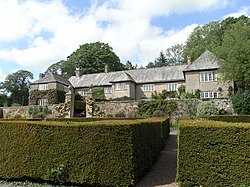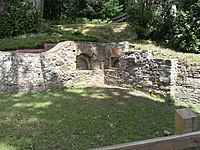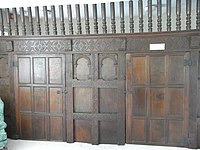Whitechapel Manor
| Whitechapel | |
| Devon | |
|---|---|
 Whitechapel Manor | |
| Location | |
| Grid reference: | SS75102728 |
| Location: | 51°1’53"N, 3°46’57"W |
| Village: | Bishop's Nympton |
| History | |
| Country house | |
| Information | |
Whitechapel Manor is a 16th or 17th century country house presiding over the anciet manor of Whitechapel within the parish of Bishop's Nympton, in northern Devon.
This manor was the earliest known residence of the locally influential Bassett family until 1603.[1] The core of the present manor house is late 16th or early 17th century, with later additions and alterations, and is classed as a Grade I listed building.[2]
History
The Domesday Book of 1986 has an entry for the manor of Nimetone, showing it to be a large manor with land for 52 ploughs, is listed as one of 24 holdings of the Bishop of Exeter, and was held by him in demesne. It does not mention Whitechapel or any sub-manors within Nimetone.[3] The first record of Whitechapel as a member of the manor of Nymeton Episcopi is in the records of Feudal Aids, where it is called in French La Chapele and in Latin Alba Capella ("White Chapel")[4]
Next to the manor house there are remains seemingly of a gothic window below ground level within a low building, but the evidence is not certain that this relates to the Whitechapel.[5] Some sources indeed identify this as a bee bole.
The Jacobean Devon historian Tristram Risdon in his work "The Survey of Devon" stated that Whitechapel was "the ancient inheritance of the Peverells".[6] He related that Sir William Peverell gave the manor of Whitechapel as the dowry of his sister Lucea on her marriage to Sir Alan Basset,[6] and it thus became a possession of the Basset family for many centuries. The adjacent manor of La Hayne, today the site of North Hayne and South Hayne farms, was also part of the dowry.[7]
Sir Robert Bassett (1573–1641) was of Plantagenet blood, which prompted him to join the two hundred or so other pretenders who made personal claims to the throne of England following the death of the last of the Tudors, Queen Elizabeth I (1558–1603). This move, which had no chance of success, was viewed with great displeasure by the new King James I, prompting Bassett to flee to France, "to save his head" according to Prince. He was however soon pardoned, but with the imposition of a very heavy fine, and returned to England where in order to pay the fine he sold Whitechapel in 1603,[8] along with thirty other manors. The Bassett family remained at Heanton Court and Umberleigh until 1802 when the male line died out,[9] but continued at Watermouth Castle and Umberleigh successively in the Davie-Bassett family and Williams-Davie-Bassett family, descended from the female line,[9] until the early 20th century.
The Amerye family acquired Whitechapel following its sale by Sir Robert Bassett, and held it until about 1660.[10]
Westcote, writing in about 1630, stated "Whitechapel (is) now divided among divers. In the farmhouse is the remainder of the tribe of Amory seated". His editor added later "Extinct about the year 1670". After 1666 it was in disputed ownership between the families of Amory, Gibbens and Lear. In about 1800 the manor of Whitechapel was in Chancery and was sold at public auction by order of the Lord Chancellor. The purchaser was John Sanger of nearby South Molton, who later boasted that the purchase had financed itself, he having cut down and sold enough timber on the estate to cover the purchase price. He resided at Whitechapel until his death on 14 February 1806.[11]
In his book The Blackmore Country (1911), Frederick Snell reported that Whitechapel was owned by "Captain Glossop", adding that:
the place is now in thoroughly good hands but it has naturally suffered from having been so long a farmhouse the occupiers of which were profoundly indifferent to its contents and history. The present owner, Captain Glossop, when I met him, was bringing taste and energy to bear on the old mansion, although portions of it were beyond repair.[12]
By 1926 Whitechapel was owned by Albert William Lloyd (1871–1952), whose great-great-grandfather had co-founded Lloyds Bank in 1765. With no descendants surviving to adulthood though, Mrs Lloyd's nephew, Colonel Baylay, inherited and sold the estate. It was split into various lots, one being the manor house with about 14 acres of land, and another being the cottages and farm buildings with Whitechapel Moor, covering about 300 acres.
In 1984 John Shapland and his wife Patricia purchased the house with 14 acres, and converted it into a luxury hotel which opened in 1987.
References
- ↑ Prince, John: 'Worthies of Devon' (1710)
- ↑ Whitechapel Manor, Bishop's Nympton - British Listed Buildings
- ↑ Thorn, part 1, 2,21
- ↑ Feudal Aids , Vol.1, p.343, quoted in Morris, Part 2, 2,21; Also, Calendars of Inquisitions Post Mortem, vol.4, no.245
- ↑ Coulter, p.24
- ↑ 6.0 6.1 Risdon, p.310
- ↑ Gentleman's Magazine, vol.68, p.765
- ↑ 1603 per introductory history to catalogue B264, National Archives
- ↑ 9.0 9.1 Vivian, p.48
- ↑ National Archives, North Devon Record Office, South Molton Records B264
- ↑ Snell, Frederick John, The Blackmore Country, 1911, p.210
- ↑ Snell, Frederick. The Blackmore Country, 1911, p.210
- Coulter, James, The Ancient Chapels of North Devon, Barnstaple, 1993
- Meredith, Gertrude Euphemia, The Descendants of Hugh Amory 1605–1805, London, 1901
- Prince, John: 'The Worthies of Devon'
- Risdon, Tristram, The Survey of Devon, c. 1630, 1810 edition
- Snell, Frederick John, The Blackmore Country, 1911, history of Whitechapel, pp.209-212]
- Vivian, Lt.Col. J.L., (ed.) The Visitations of the County of Devon: Comprising the Heralds' Visitations of 1531, 1564 & 1620, Exeter, 1895

